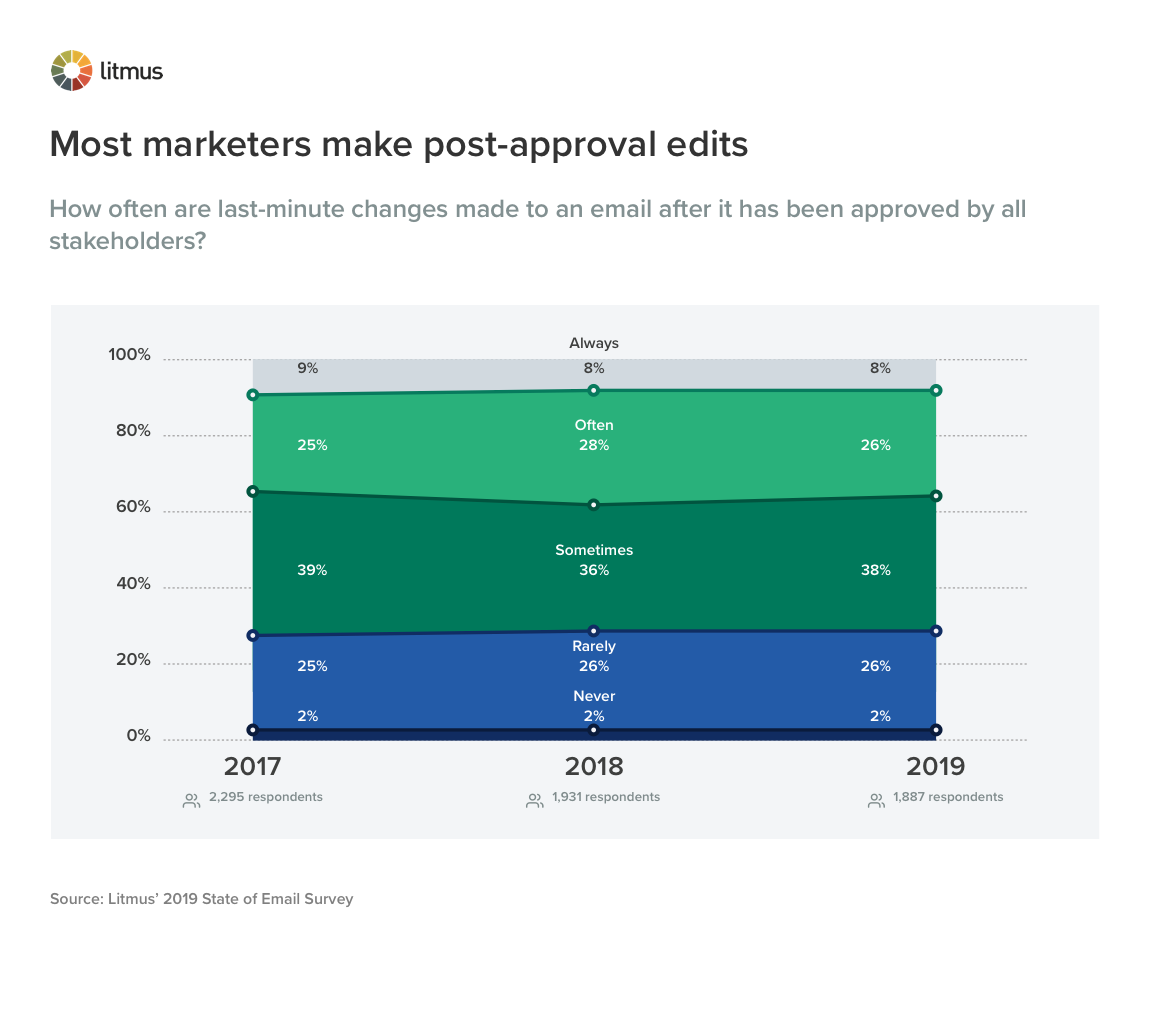The Dangers of Last-Minute Changes to Emails (and How to Avoid Them)
“Oh, I’ll just make this one little tweak before we send…” Nope. No. Don’t do it.
It may be tempting to make a small change to an email after it’s been approved and tested. Perhaps you want to tweak an image, add another section, or update a link. While it may seem harmless to make these small, last-minute changes, they can trigger a negative chain reaction.
Email apps change all the time—and all of the constantly moving variables mean that even the tiniest update can lead to deliverability or rendering errors. If you’ve ever been tempted to make a last-minute change, though, you aren’t alone.
Our 2019 State of Email Workflows report uncovered how close a lot of email marketers are flying to the sun.
Making last-minute email changes is common

When done well, email marketing can have a “pinch me” level ROI. The drive to deliver a great experience to customers and reach the average return on investment of $42 to $1 means that email marketers are committed to perfection.
So much so that 72% of email marketers in 2019 said they make last-minute changes to an email at least sometimes.
That breaks down to 8% always making changes, 26% often editing after approval, and 38% sometimes sneaking in a tweak. These numbers prove it’s really common to change an email after it’s been approved by all stakeholders—and that’s a problem. Here’s why:
Post-approval edits lead to costly errors
Those quick last-minute changes often happen when a deadline comes up. You might update that link or swap out that image under time pressure and skip another round of QA to ensure you hit the deadline. That’s when errors sneak in.
Whenever you make a change to your email—no matter how small—it’s crucial to re-test your email to ensure it looks great and works as intended. You should never skip that step of the process.
But why is there even a need for last-minute changes after your team has already signed off on the email?
A well-functioning review process should help you collect feedback from stakeholders, catch any errors, and give you confidence that your email is nothing but perfect. So, if you’re among the marketers who frequently make changes to an email after it’s been approved, that’s a telling sign that your review and approval workflow wasn’t effective in the first place.
Improve your review process and cut the need for last-minute updates
If email testing is essential—and our community knows it is—then what could cause all of these post-approval changes? A burdensome approval process could be to blame. Scattered or contradicting feedback, too many cooks in the kitchen, or an unclear process can lead to edits slipping through the cracks. A drawn-out process may also leave you wanting to bypass the normal checkpoints when the change seems small or insignificant.
If you find yourself making changes to an email after it’s approved, it’s time to assess the situation. First, look at what changes you’re making. Is there a point in the process where the edit should have been caught and updated?
Plus, consider these tips for a more streamlined approval process:
- Have two to three team members review each campaign
The need for two or three people to sign off on an email appears to be the sweet spot for a balanced, appropriate email approval process. If more people are involved, marketers say the approval process becomes cumbersome. If only one person is involved, it becomes too lax. - Collect and manage feedback in a single place
If you’re among those marketers who receive feedback verbally or through a multitude of channels, make it a priority to improve that process. The more scattered feedback is, the more likely it is that errors will happen and mistakes will slip through. Figure out how to centralize feedback to keep everything in one place, keep projects moving, and avoid errors. Tools like Litmus Proof can help. - Give reviewers enough time to review and approve emails
If your reviewers feel rushed, it’s likely that they don’t take as close of a look as they should, making it more likely that mistakes get missed. When planning your campaigns, slot in enough time for a thorough review process.
Streamline your email review process and stop last-minute changes in their tracks with Litmus Proof
Say goodbye to juggling feedback from different communication channels. Share feedback, consolidate conversations, and resolve questions in a single, centralized application with Litmus Proof.
Learn more about Litmus Proof →

Steph Knapp
Steph Knapp is a Freelance Content Writer for SaaS and B2B companies

